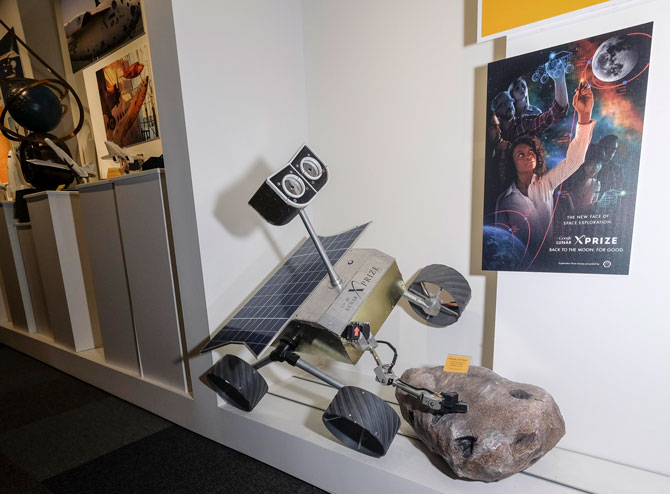
Consider this a moon-shot project.
X Prize Foundation is dangling $30 million in total prize money for a private team to land a robotic rover on the moon, travel at least 500 meters (1,640.4 feet) on the dusty lunar surface, and transmit video and other data back to Earth.
The contest, the Google Lunar X Prize, was announced in 2007 and is the largest purse the Culver City-based nonprofit has offered. The competition’s deadline was recently extended to March 31 in order to give five remaining teams more time to launch and land on the moon.
Such multimillion-dollar prizes – there have been 16 contests in total – have stimulated dozens of research and development projects, including handheld blood-testing devices, fuel-efficient cars and spaceships, for nonprofit and for-profit ventures alike. X Prize has awarded a total of $33.5 million since its 1995 inception and has an additional $86.8 million on the table for active competitions, including the moon expedition.
The first aim of the Lunar X Prize is to spur scientific innovation, though such prizes also aim to make an impact on nascent industries, said Chanda Gonzales-Mowrer, senior director of the Google Lunar X Prize competition.
“The first goal of the prize was to inspire people to compete, to look at the prize as an inspiration to pursue (science, technology, engineering and math) education,” she said. “The second goal of the prize was to get engineers, innovators and entrepreneurs to develop low-cost methods for robotic exploration that will push the new space industry. Hopefully, that will drive down the cost of lunar exploration.”
Current contestant Moon Express of Cape Canaveral, Fla., and former contestant Astrobotic Technology of Pittsburg have ambitions beyond the contest, including moon mining and exploration.
“For many of the teams, they wouldn’t have formed if it wasn’t for this competition,” said Gonzales-Mowrer. “The competition gave them the drive to start a business.”
Aviation prizes have a long history in Southern California.
The X Prize was modeled on the $25,000 Orteig Prize, which aviator Charles Lindbergh won in 1927 for flying nonstop from New York to Paris. His plane, the Spirit of St. Louis, was manufactured and partially financed by Ryan Aeronautical Co. of San Diego – now part of Northrop Grumman of Falls Church, Va.
Later in 1927, James Dole, founder of Westlake Village-based Dole Food Co. Inc., offered $25,000 for an air race from Northern California to Hawaii – a contest that paved the way for the first flight of Pan American Airways’ Flying Clipper from San Francisco to Honolulu.
Dole’s aim was to stimulate the commercial development of an aerial route that would dependably serve the Hawaiian Islands, according to the Pan Am Historical Foundation. Such a route would presumably expedite delivery of his perishable pineapples to the U.S. mainland.
The X Prize Foundation’s most famous competition, the $10 million Ansari X Prize contest to launch a reusable manned spacecraft into space twice within two weeks, helped spur the budding space tourism industry in Southern California.
That competition was won in 2004 by experimental aircraft manufacturer Scaled Composites of Mojave. That company’s reusable-rocket technology was bought by Spaceship Co., a manufacturing subsidiary of billionaire Richard Branson’s space tourism company Virgin Galactic of Long Beach. The achievements also preceded the reusable-rocket missions of Space Exploration Technologies Corp., or SpaceX, of Hawthorne and Blue Origin of Kent, Wash.
The Ansari X Prize helped change the public perception of the private space industry, said Greg Autry, assistant professor of clinical entrepreneurship at USC’s Marshall School of Business.
“I don’t think you’d see as much money going into other space ventures if you didn’t have that tipping point with the Ansari prize,” he said. “Here was a group of guys building a space plane that worked for millions (of dollars), not for billions. And that created a public sense, media sense and investor sense of credibility that didn’t exist before.”
Piggybacking on past success, X Prize Foundation wants the Google Lunar competition to lay the ground work for the next phase of the space exploration industry, said Gonzales-Mowrer.
“We hope that the technologies that are created will be further used after the prize is awarded,” she said. “The moon is the steppingstone to the rest of the universe.”
